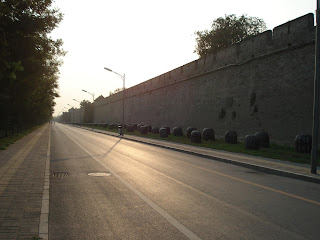LuGouQiao (卢沟桥) is one of the Beijing’s oldest bridges; it was built in 1189 during Jin’s Dynasty. It is located about 15km away at the south-west of Beijing town city. However, it was damaged and re-built for quite a number of times ever since 1189. Luckily, the structure and its signature lion sculptures are maintained even after so many times of renovation.
The history of Lugouqiao is very interesting. It is also known as the Marco Polo Bridge in English because it was described in Marco Polo’s travel note. It is listed as one of the Beijing 8 Scenes (燕京八景 – 卢沟晓月) since Jin Dynasty. It is said that the moon at Lugouqiao is more charming.
In 1973, the Japanese attacked on the bridge and started Japanese invasion of China, this incident is well known as Macro Polo Bridge Incident (七七事变). Anti Japanese War started here in WanPing City (宛平城). The artillery hold is still maintained on the wall of Wanping City along the Chengnan St. (城南街). Memorial monuments are along the road to grieve over the anti-war soldiers. The Chinese People’s Anti-Japanese War Sculpture Park (中国人民抗日战争纪念雕塑园) is next to the Wanping City. Visitors can get a ticket and visit the park and understand more about the history of the Anti-Japanese War.
The stone Lion sculptures are the most interesting feature on the bridge. There are about 496 big and small stone lions with different posture and expression sitting on 281 balusters. According to the information, there are a few sayings about the exact number of lions. Peoples saying that the stone lions on Lugouqiao hard to be count clearly. As I walked along the bridge, I realized the stones or marbles used for the lion sculptures are different. I believe that this is due to its several renovations along different dynasty. As the dynasty change, the material and the handwork skill varied too.
During the renovation on 1986, portion of the bridge old surface are remained and maintained on the bridge for visit. You will really feel the magnificent of the bridge when u walk along it. Non of the lion is similar to each other, and each with different expression; some with angry face, some look serious and guarding the bridge; some are happy and play around with small lions; some are fierce and bullying small lions. There are a lot more, you should really take a look yourself here on this bridge if you like stone lions.
The journey to Lugouqiao from Beijing city is actually quite far. We took bus from one of the bus stop along ZhuShiKou Street (珠市口大街) to KangZhanDiaoSuYuan Stop (抗战雕塑园站). It took us about 1 hour plus to reach there. My mother felt dizzy after the long distance travel on bus. So we went into one of the restaurant along the XiaoYue Mid Road (晓月中路) for some food. At last, my mother still gave up walking over to the bridge.
From the bus stop, you need to walk across the flyover (the G4 Jinggang’ao Expressway) to the DongGuan South Street (东关南街). Walking along the Dongguan S. St, you will reach to a parking lot on left, and there is the Sculpture Park I mentioned above. Take a left turn into the Chengnan St next to the Sculpture Park; on your right, that is wall for the Wanping City. Along the road is the Anti-Japanese War Relic area. To go to the Lugouqiao, you got to walk all the way to the end of the Chengnan St and turn right. You should see the bridge heritage area not far away on your left.
There is some display sculptures and information about the bridge building history at the entrance of the Lugouqiao Heritage Area.
This is definitely a worth-to-go attraction in Beijing. The bridge and the heritage are well protected. Besides the history, sunset at Lugouqiao is also quite nice.
Travel Tips:
Lugouqiao entrance ticket price: RMB 20
Opening Hours:
7 .00 - 19.00, 1st April - 31th October
8.00 - 17.00, 1st November - 31th March
Around Lugouqiao:
WanpingCity (宛平城),
Display Hall of Historical Information of Lugouqiao (卢沟桥史料陈列馆),
Chinese People’s Anti-Japanese War Memorial Hall (中国人民抗日战争纪念馆),
Macro Polo Bridge Incident Relic Site (七七事变弹坑遗址),
Chinese People’s Anti-Japanese War Sculpture Park (中国人民抗日战争纪念雕塑园)
Reference Maps:
View Larger Map


































LuGouQiao (卢沟桥) is one of Beijing’s oldest bridges; it was built in 1189 during the Jin Dynasty. It is located about 15km southwest of Beijing downtown.
ReplyDeletehola amigos, everyone is wierd
ReplyDeleteeveryones weird
ReplyDeleteyour weird
ReplyDeleteHey Eric
ReplyDeletehi
ReplyDeletehey two current people
ReplyDeleteThank You and I have a neat offer you: What Renovations Increase The Value Of A Home home reno costs
ReplyDelete